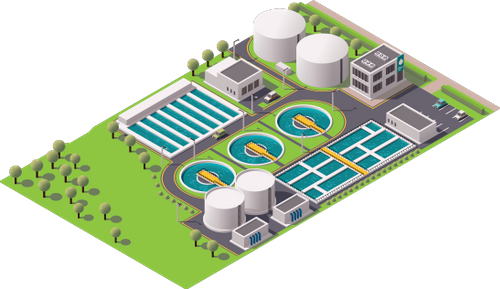Water Treatment Plants
Water Treatment Plants
What are they?

Water treatment is a process that alters the chemical and/or physical properties of source water so that it can be used for a specific purpose. Water is treated before it is used for drinking water, industrial processes, irrigation, water recreation, or before being safely returned to the environment. Water treatment plants are facilities that remove harmful or undesirable substances from the source water, producing water that is fit for its specific purpose.
Federal and provincial health-related standards and guidelines outline the requirements for water that is delivered to your home. All potable water in Alberta must meet the Guidelines for Canadian Drinking Water Quality, published by Health Canada. These guidelines can be found here.
How do water treatment plants impact water quality in the Bow River Basin?
Water treatment plants remove contaminants from source water (e.g., the Bow River) through the addition of certain substances for disinfection and flocculation (settling).
Disinfection may be achieved using chlorine, ultraviolet light, chlorine dioxide, or ozone. Disinfection is required at drinking water facilities to ensure a required level of pathogen reduction is achieved. See the fact sheet on Microorganisms.
The Bearspaw Water Treatment Plant is a pre-treatment facility that uses a process known as “flocculation” to capture and remove silt, debris and micro-organisms from the raw water supply. Chlorine is added to the clarified water, which then rests for enough time to disinfect the drinking water by killing microorganisms and viruses that can cause disease. The final filtration step removes any remaining silt, debris and microorganisms from the water with a number of large filtration beds made of crushed coal and crushed sand.
What can we do about it?
Protecting upstream ecosystems is very important in maintaining good source water quality. Good source water quality means fewer substances (e.g., chlorine) are needed to make the water safe. This strategy is called “source water protection.” Source water protection initiatives and regulations are implemented at provincial, municipal, and local levels.
Where can I find more information?
The Bearspaw Water Treatment Plant online tour
Sources:
Reid, D. (2012, April). Standards for Municipal Waterworks (Part 1 of 5). Retrieved from: http://aep.alberta.ca/water/programs-and-services/drinking-water/legislation/documents/Part1-StandardsMunicipalWaterworks-2012.pdf
Alberta Environment and Parks (2016, Aug. 18). Groundwater. Retrieved from: http://aep.alberta.ca/water/programs-and-services/groundwater/default.aspx
Alberta Environment and Parks (2016, July 21). Drinking water. Retrieved from:http://aep.alberta.ca/water/programs-and-services/drinking-water/default.aspx
Battle River Watershed Alliance. (2014, September). Watershed Management Plan: Water Quality Component, Source Water Protection: Policy Advice. Retrieved from: http://aep.alberta.ca/water/programs-and-services/water-for-life/partnerships/watershed-planning-and-advisory-councils/documents/BattleRiverSourceWaterProtection-Sep2014.pdf
